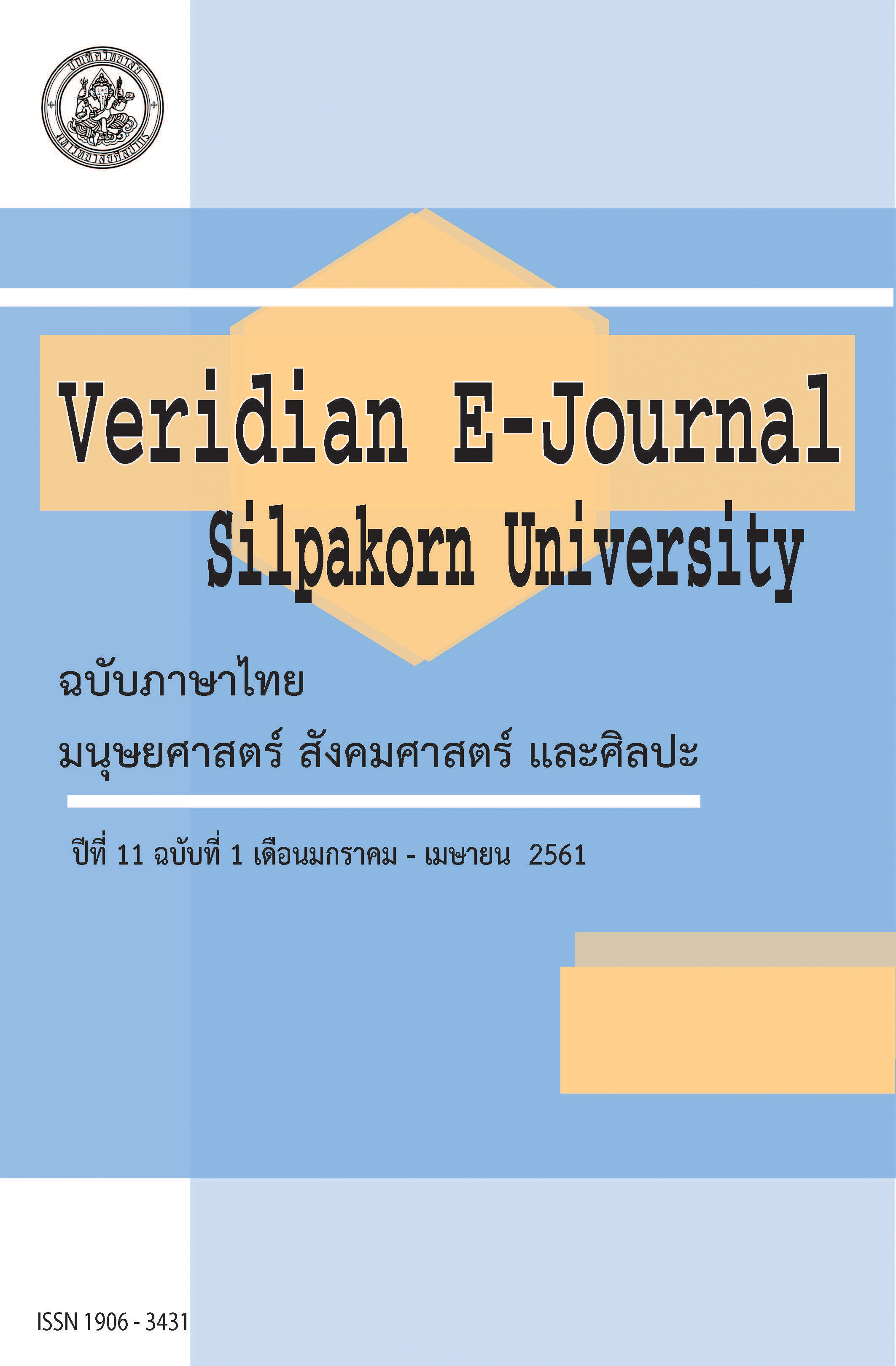การจัดการความขัดแย้งทางการเมืองในจังหวัดชัยนาท (Political conflict management in Chainat Province)
Main Article Content
บทคัดย่อ
การวิจัยครั้งนี้มีวัตถุประสงค์เพื่อ 1) ศึกษาปัจจัยที่มีความสัมพันธ์กับการจัดการความขัดแย้งทางการเมืองในจังหวัดชัยนาท 2) ศึกษาสาเหตุความขัดแย้งทางการเมือง 3) ศึกษาการจัดการความขัดแย้งทางการเมืองด้วยความร่วมมือของภาครัฐ ภาคประชาชน และภาคประชาสังคม 4) ศึกษาปัญหาและอุปสรรคในการจัดการความขัดแย้งทางการเมืองในจังหวัดชัยนาท การศึกษาวิจัยครั้งนี้ใช้วิธีการวิจัยแบบผสมผสาน (Mixed Method Research) โดยเป็นการวิจัยแบบขั้นตอนเชิงสำรวจ (Explanatory Sequential Design) แบ่งเป็น 2 ขั้นตอน ช่วงแรกการวิจัยหลักเป็นการวิจัยเชิงคุณภาพ(Qualitative Research)เพื่อสำรวจหัวข้อการวิจัยและช่วงหลังเป็นการวิจัยเชิงปริมาณ(Quantitative Research)เพื่อยืนยันผลสำรวจที่ได้เครื่องมือในการวิจัยเชิงคุณภาพผู้วิจัยใช้วิธีการสัมภาษณ์เชิงลึก (In-depth Interview) ผู้ให้ข้อมูลสำคัญ (Key Informant) โดยวิธีเฉพาะเจาะจง (Purposive Sampling) ตัวแทนจากภาคส่วนต่างๆ จำนวน 16 คน ที่มีส่วนเกี่ยวข้องกับการจัดการความขัดแย้งทางการเมืองในจังหวัดชัยนาท ประกอบด้วยตัวแทนจากภาครัฐ ตัวแทนจากองค์กรปกครองส่วนท้องถิ่น ตัวแทนจากภาคประชาชนและตัวแทนจากภาคประชาสังคม โดยใช้เทคนิคการสัมภาษณ์แบบมีโครงสร้าง (Structured Interview) รวมถึงการจัดกิจกรรมสานเสวนาเรื่อง “สมานฉันท์ชาวชัยนาท”โดยผู้มีส่วนได้ส่วนเสียเข้ามามีมาส่วนร่วมในการสานเสวนาและมีการสังเกตการณ์อย่างไม่มีส่วนร่วม (Non-participation Observation) ผู้วิจัยนำข้อมูลที่ได้จากการสัมภาษณ์เชิงลึก)ผู้ให้ข้อมูลสำคัญ และข้อมูลที่ได้จากการจัดกิจกรรมสานเสวนาเรื่อง “สมานฉันท์ชาวชัยนาท”รวมถึงข้อมูลที่ได้จากการสังเกตการณ์อย่างไม่มีส่วนร่วม (Non-participation Observation) มาวิเคราะห์เนื้อหา (Content Analysis) ด้วยการให้ความหมายและการตีความและนำข้อมูลมาตรวจสอบแบบสามเส้า (Triangulation) ประกอบด้วยการตรวจสอบด้านเอกสาร การตรวจสอบด้านบุคคลจากนักวิชาการผู้เชี่ยวชาญและทฤษฎีที่เกี่ยวข้องการจัดการความขัดแย้งทางการเมืองรวมถึงการตรวจสอบจากผู้วิจัย
เครื่องมือในการวิจัยเชิงปริมาณ คือ แบบสอบถาม โดยผู้วิจัยใช้การสุ่มกลุ่มตัวอย่างแบบความน่าจะเป็น (Probability Sampling) โดยใช้การสุ่มตัวอย่างแบบหลายขั้นตอน (Multi-stage Random Sampling) โดยมีขั้นตอนดังนี้ ขั้นตอนแรก ทำการแบ่งกลุ่มชั้นเดียว (Custer Sampling) คือ แบ่งจังหวัดชัยนาทตามเขตการปกครอง แบ่งออกเป็น 8 อำเภอ ดังนี้ อำเภอเมืองชัยนาท อำเภอหันคา อำเภอวัดสิงห์ อำเภอเนินขาม อำเภอสรรคบุรี อำเภอมโนรมย์ อำเภอหนองมะโมง อำเภอสรรพยา และทำการสุ่มตัวอย่างแบบง่ายโดยเอารายชื่ออำเภอทั้งหมดมาทำการจับสลาก แบ่งจาก 8 อำเภอเหลือ 4 อำเภอ ขั้นตอนที่สอง ทำการสุ่มตัวอย่างแบบง่าย โดยเอารายชื่อตำบลทั้งหมดของแต่ละอำเภอมาทำการจับสลาก โดยทำการสุ่มตำบลของแต่ละอำเภอ จำนวน 2 ตำบล รวมทั้งสิ้น 8 ตำบล ขั้นตอนที่สาม ผู้วิจัยทำการสุ่มกลุ่มตัวอย่างแบบไม่ใช้ความไม่น่าจะเป็น (Non -Probability) โดยใช้การเลือกกลุ่มตัวอย่างแบบเจาะจง (Purposive Sampling) เก็บข้อมูลกับกลุ่มตัวอย่างทั้งเพศชายและหญิงที่มีอายุระหว่าง 18-60 ปี อาศัยอยู่ใน 8 ตำบล ไม่น้อยกว่า 5 ปี ครัวเรือนละ 1 คน โดยทำการสุ่มจนครบจำนวน 400 คน สถิติที่ใช้ในการวิจัยประกอบด้วยสถิติเชิงพรรณนา (Descriptive Statistic) ใช้อธิบายลักษณะพื้นฐานส่วนบุคคล ระดับการเลือกแบบการจัดการความขัดแย้งโดยนำเสนอข้อมูลการแจกแจงความถี่ ค่าร้อยละ(%) ค่าเฉลี่ย (xˉ) ส่วนเบี่ยงเบนมาตรฐาน S.D. เพื่อพรรณนาเกี่ยวกับลักษณะทั่วไปของกลุ่มตัวอย่างที่ศึกษา ประกอบด้วยข้อมูลปัจจัยส่วนบุคคล ข้อมูลเกี่ยวกับความคิดเห็นของกลุ่มตัวอย่างที่มีต่อรูปแบบการจัดการความขัดแย้งทางการเมือง และสถิติเชิงวิเคราะห์ (Analytic Statistic) ใช้วิเคราะห์ความสัมพันธ์ของปัจจัยส่วนบุคคล ประกอบด้วย เพศ อายุ การศึกษา สถานภาพ อาชีพ และระยะเวลาที่อาศัยอยู่ในชุมชน กับรูปแบบการจัดการความขัดแย้งในรูปแบบตารางไขว้ (Cross tabulation) ด้วยสถิติ Chi-Square ผู้วิจัยได้ทำแบบสอบถามไปทดสอบความเชื่อมั่น (Try Out ) กับกลุ่มประชากรที่มีลักษณะใกล้เคียงกับกลุ่มตัวอย่าง โดยวิธีหาค่าสัมประสิทธิ์สหสัมพันธ์แอลฟ่า (∝-coefficient) ของครอนบาค (Cronbach) โดยได้ค่าความเชื่อมั่น .79 ซึ่งถือว่าเป็นค่าความเชื่อมั่นที่ยอมรับได้
ผลการวิจัยพบว่า 1) ปัจจัยที่มีความสัมพันธ์กับการจัดการความขัดแย้งทางการเมืองในจังหวัดชัยนาท มีดังนี้ ผลการศึกษาความสัมพันธ์ระหว่างตัวแปรเพศกับรูปแบบการจัดการความขัดแย้งแบบประนีประนอม พบว่า ไม่มีความสัมพันธ์กันอย่างมีนัยยะสำคัญทางสถิติที่ระดับ .05 ส่วนความสัมพันธ์ระหว่างตัวแปรอายุกับรูปแบบการจัดการความขัดแย้งแบบประนีประนอม พบว่า ตัวแปรทั้งสองมีความสัมพันธ์กันอย่างมีนัยยะสำคัญทางสถิติที่ระดับ .05 เมื่อวิเคราะห์ความสัมพันธ์ระหว่างตัวแปรสถานภาพและตัวแปรระยะเวลาการอาศัยอยู่ในชุมชนกับรูปแบบการจัดการความขัดแย้งแบบประนีประนอม พบว่า ตัวแปรทั้งสองไม่มีความสัมพันธ์กันอย่างมีนัยยะสำคัญทางสถิติที่ระดับ .05 2) สาเหตุความขัดแย้งทางการเมืองมีสาเหตุเกิดจากความขัดแย้งด้านข้อมูลข่าวสาร ด้านโครงสร้าง ด้านผลประโยชน์ และด้านวัฒนธรรม 3) การจัดการความขัดแย้งทางการเมืองด้วยความร่วมมือระหว่างภาครัฐ ภาคประชาสังคมและภาคประชาชน มีดังนี้ 1. การกระตุ้นความร่วมมือ โดยภาครัฐมีการสนับสนุนด้านบุคคลากร งบประมาณ และข้อมูล 2. การสร้างกรอบความร่วมมือ โดยมีการระบุเป้าหมายทั้งระยะสั้น ระยะกลางและระยะยาว 3. การระดมความร่วมมือ โดยมีการบูรณาการความร่วมมือในการจัดการความขัดแย้งทางการเมืองผ่านการจัดกิจกรรมร่วมกันโดยอาศัยงานประเพณีวัฒนธรรมมาเป็นสิ่งจูงใจ รัฐมีการส่งเสริม สนับสนุนงบประมาณ ภาคประชาสังคมเป็นเจ้าภาพในการจัดกิจกรรมในการประชาสัมพันธ์ 4. การสนธิความร่วมมือ โดยการแลกเปลี่ยนข้อมูลข่าวสารระหว่างกันในรูปแบบของการจัดระบบเครือข่าย และ 4) ปัญหาและอุปสรรคในการจัดการความขัดแย้งทางการเมือง คือ ระบบการศึกษาที่มิได้ให้ ความสำคัญกับการส่งเสริมความรู้ความเข้าใจด้านสันติวิธี การจัดการความขัดแย้ง และบทบาทหน้าที่ของพลเมืองในระบอบประชาธิปไตยให้กับประชาชน และวัฒนธรรมอุปถัมภ์ ส่วนปัจจัยแห่งความสำเร็จ คือ การใช้สันติวิธีในการแก้ปัญหาความขัดแย้ง รับฟังความคิดเห็นต่างของทุกฝ่าย มีการจัดการสานเสวนาโดยทุกฝ่ายมีส่วนร่วม
The objectives of this research were aimed to 1) study the factors that related to political conflict management in Chainat province 2) study causes of political conflict 3) Study the political conflict management through the cooperation of the government agency, the public sector, and the civil society sector 4) Study the problems and obstacles in the management of political conflict in Chainat province. A mixed methodology was used according to this research. The two stages of explanatory sequential design were analyzed in which the qualitative approach was used in the primary stage to investigate the title of the research and the quantitative approach was analyzed in the second stage to insist the findings. In-depth Interview was used to collect the related information. 16 key informants from districts were derived from purposive sampling. They were involved with the political conflict management in Chinat province, comprised of governor agent, local governor agent, local people agent, and civil society agent. The structured interview was employed, including Dialogues Conversations about “The Reconciliation of Chinat people.” The stakeholders were participated in this activity and employed non-participation observation. The content analysis was derived from the in-depth interview, structured interview, the Dialogues Conversations, and non-participation observation in order to define, interpret and triangulate from academics, experts, and related review literature in political conflict management.
The quantitative approaches were derived from questionnaires in which the probability sampling was employed by using multi-stage random sampling with the followings procedures: 1) Custer sampling was used to divide govern areas in Chainat province into eight districts: Muang Chainat, Hanka, Watsing, Noenkham, Sankhaburi, Manorom, Nongmamong and Sapphaya District. Simple random sampling was used to select only four districts out of eight. 2) Simple random sampling was employed in order to select only two sub-districts from eight. 3) Non-probability was selected to collect demographic data by using purposive sampling to collect gender information with aged range between 18-60 years, who had been living in eight sub-districts for not less than five years. This random sampling was select one person in a household in order to gain the sample size of 400. Descriptive statistic was used to examine the frequency, percentage, mean, standard deviation (S.D.) in order to describe general personal characteristics, the levels of conflict and opinions towards political conflict management. The analytic statistic was used to analyze the relationship between personal factors such as gender, age, educational background, status, occupation and length of living in the community and the conflict management model in cross-tabulation table which examined by Chi-square. The questionnaire was examined the reliability with similar sampling size by seeking out the correlation coefficient alpha (∝-coefficient) of Cronbach’s Alpha, in which the reliability was 0.79.
The findings of the study were as follows: 1) Factors that related to the political conflict in Chainat, as follows: the findings of the relationship between gender and model of compromising in conflict management was revealed that there was a statistically significant (P < 0.05). An analysis of the relationship between status and the length of living in the community with compromising in conflict management was revealed that there was no statistically significant (P > 0.05). 2) The causes of political conflict were information conflict, structural conflict, beneficial conflict, and cultural conflict. 3) The co-operation between the government sector, civil society and the people to: 3.1 encourage the co-operation by the government support in human resources, budget, and relevant information; 3.2 create a partnership by purposing short-term, middle-term and long-term target; 3.3 mobilize the co-operation by integrating collaboration in political conflict management through collective incentive cultural activities, moreover, the government provided the financial support, the civil society was the host in public relations; 3.4 to associate with the cooperation with the exchange of information among them through network. 4) the problems and obstacles in political conflict management in Chinat province was the education system was not provided the essential to promote the knowledge of peaceful, conflict management and the roles of citizens in a democracy to people and cultural patronage. The success factor was to use the peaceful method to resolve the conflict, listen to the opinions of all sides and provide the dialogues conversations that all parties are involved.

